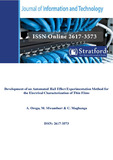Development of an Automated Hall Effect Experimentation Method for the Electrical Characterization of Thin Films

View/
Date
2023-10Author
OREGA, OWEN ALFREDS
M, Mwamburi
C., Maghanga
Metadata
Show full item recordAbstract
There has been drastic growth in the microelectronics industry in the recent past. The
performance of these materials is influenced by their structural, electrical, and optical
properties among others, depending on their applications. Therefore, the need to conduct
measurements of the semiconductor characteristics precisely, quickly, and conveniently cannot
be overstated. Some of the desirable features of measurements include usability, accuracy,
resolution, repeatability, and consistency which cannot be assured with manually operated
systems. This study strived to design and interface an automated computer-aided four-point
probe test equipment that characterizes materials to determine their electrical properties. A
four-point probe head, an electromagnet, NI Keithley model 6220 Precision current source,
model 7001 switch, model 2182A Nanovoltmeter, and model 7065 Hall Effect card instruments
were interfaced with the NI LabVIEW program running in a computer through a GPIB hub to
a PC USB for its full control. The four-probe head was utilized to probe the samples with a
square symmetry that was adopted for the measurement of the semiconductor properties.
Reliability tests were conducted on a standard P-type Germanium sample. The collected data
was within 0.32% of the expected results. This work forms a basis for automating similar
systems that were inherently designed to be operated manually.
